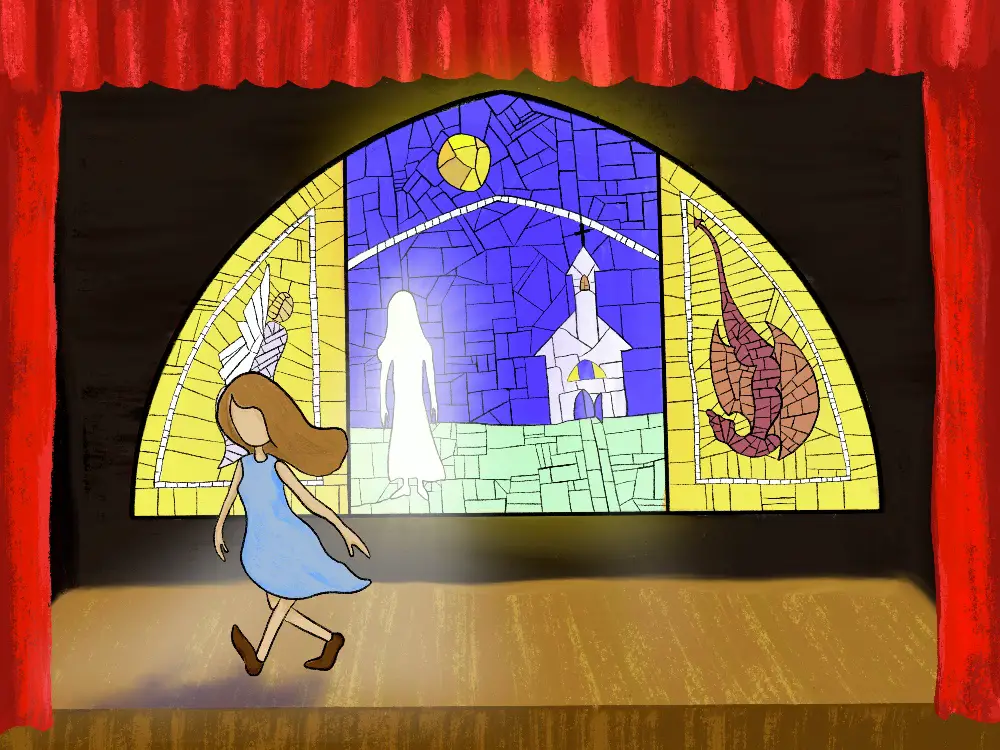How the play “Mary Gets Hers” transports the audience to a world that is visually ancient yet thematically familiar.
Although it is impossible for a modern person to just wake up in a field shining under the same sun as ours just one thousand years ago, we can always try to recreate that field. The play “Mary Gets Hers”,written by Emma Horwitz and directed by Josiah Davis, attempts to accomplish such a goal at the Robert W. Wilson MCC Theater Space in Hell’s Kitchen. The duo utilized many facets of their production to convey the immersion that was required to understand their world; from dialogue to sound effects, music and visuals, the audience is transported to 10th century Germany during a plague.
Yet the most impressive aspect of this production comes before the first audition is even held and by writer, Emma Horwitz, a writing fellow at Playwrights Realm. Though Emma has had her work workshopped and produced at Brown University, “Mary Gets Hers” is her first full length production off-Broadway. Her feat is only strengthened by Horowitz’ age of thirty-one, surprisingly young for a published playwright. Josiah Davis who’s directed multiple productions such as “Wolves eat Elk”, “Clydes”, “Julius Caesar” and many more, utilized his experience and imagination to create scenes that are just as immersive in memory as they are on stage.
The play “Mary Gets Hers”’ is Horwitz’s retelling of written by Hrotsvitha of Gandersheim during the 10th century. Hrotsvitha’s original play follows Mary, Abraham’s niece, as she abandons the solitary life of religion only to end up a harlot for two years. She is then rescued by Abraham and spends the next two decades repenting through fasting, crying, praying and holding vigils.
“Mary Gets Hers” tells the tale of a young orphan girl, Mary, who gets adopted by a pair of hermit monks, Abraham and Ephraim after her parents die from a plague. Abraham keeps Mary locked up in a cell for most of her time there, so as to protect her from the “taint of sin.” Though Mary is initially content with her situation, growing up locked away from the outside world leads to her desire for freedom, independence and emotional connections, as would any teenage girl . She is then convinced to run away and live with a sketchy innkeeper who promises her food and shelter. In return he exploits Mary’s naivety for financial gain, introducing her to a lot of “lovers” and, though nothing is explicitly shown or said, draws significant parallels to prostitution. After Mary’s escape, the conflict compelsAbraham, a veteran, to call the Soldier, an old friend, to look for Mary. After two years, Soldier finally discovers an older Mary where she displays her courage and strength although still living under the innkeeper’s rule. She keeps her strength hidden until the perfect opportunity arises to finally escape the innkeeper which isn’t until Abraham comes looking for her. In the end, Mary returns to the monastary where the hermits treat her like an adult by giving her a room, Ephraim’s hair shirt and the freedom to travel wherever she pleases.
The play’s writing is sharp, quick-witted and satirical, avoiding unnecessary dialogue and keeping the audience fully engaged. The humorous dialogue not only provided levity but also offered insight into the characters’ backgrounds. For instance, Abraham’s, a vegetarian due to religion, remarks about needing to consume “a lot” of meat and wine to complete his mission reveals his inclination towards certain vices. Instances such as this show how even the most pious have an inclination towards sin.
Each line spoken by the characters aimed to captivate the audience’s attention and, when combined with vivid theatrics, ensured the absence of dull moments or overdrawn conversations throughout the performance. Mary’s introductory monologue especially stood out due to its dramatic transition from a pitch-dark theater to the sudden onset of thunder followed by a warm spotlight center stage. Another memorable moment occurs later, at the monastery, when Abraham sings outside of Mary’s cell. Mary monologues her frustration with the monotony of her life while aging rapidly; her increasing volume and speed showcase a growing agitation. Throughout the play, Mary’s various monologues not only recount her experiences but also offer insight into her evolving emotions and perspectives at different stages of her life.
The set design of the show added another layer of immersion to the production, making the world look and sound like what one would expect of a 10th century monastery and inn. The most notable example is when Abraham and Ephraim are spending a late night praying and conversing, lit only by a soft warm spotlight mimicking a candle. As the pair speak in hushed tones, their dialogue the only audible aspect of this scene, they hear the moaning of an old hermit echo through the hall. The pair wait in silence as the monk, sleepwalking, shuffles towards them with only a candle in his hand and then shuffling away. This scene successfully conveys the sense of antiquity with stone floors, wooden doors and candles for torches.
Visually and musically, the production included scenes portraying a character’s state of mind, while also conveying the significance of what they’re seeing. A scene involving Abraham’s nightmare about a dragon, does not involve a prop or statue of a dragon on stage, instead relying on the dialogue, lighting and music to help the audience feel his nightmare; its intensity and significance. The lighting filled the stage with a crimson hue as a group of hooded monks flooded the theater with rhythmic chanting while Abraham, in the middle of the stage, monologued his nightmare. Another visual which stuck out was at the very beginning of the play, when the audience is shown the death of Mary’s family. Instead of having two actors come on stage just to die, the production instead opts to shock the audience with thunder and lightning followed by two pairs of shoes falling on the floor. This method didn’t just tell the audience that two people had died, but also the importance of their deaths. The blitz hooked the audience while the darkness and silence left them wondering what just happened.
The play “Mary gets Hers” captivates the audience, allowing them to hear, see and feel exactly how the character’s do. The production’s impressive presentation is the result of two artists, Emma Horwitz and Josiah Davis, collaborating to tell a story that means something to them and then imparting that meaning onto the audience. The play showed the audience that although a story is set in a world long gone, it’s themes can still resonate with them through the combined efforts of artists.
Source Images:
Screen+Shot+2023-10-11+at+10.10.34+AM.png
(Mary’s introduction) (Image via Playwrights Realm)
(Mary and a disguised Abraham at the Inn) (Image via Playwrights Realm)
https://images.squarespace-cdn.com/content/v1/5ee26ae2215efe5712498fb4/1697033424023-GPLCQEAJ6U6085FQU72C/Screen+Shot+2023-10-11+at+10.10.18+AM.png?format=1500w (The Innkeeper and the Soldier)(Image via Playwrights Realm) https://static.wixstatic.com/media/9c2dab_d4a48c6377ba4d70a789846c41aa515f~mv2.jpeg/v1/fill/w_2616,h_1744,al_c,q_90,usm_0.66_1.00_0.01,enc_auto/9c2dab_d4a48c6377ba4d70a789846c41aa515f~mv2.jpeg
(Abraham and Ephraim) (Image via Playwrights Realm)

















